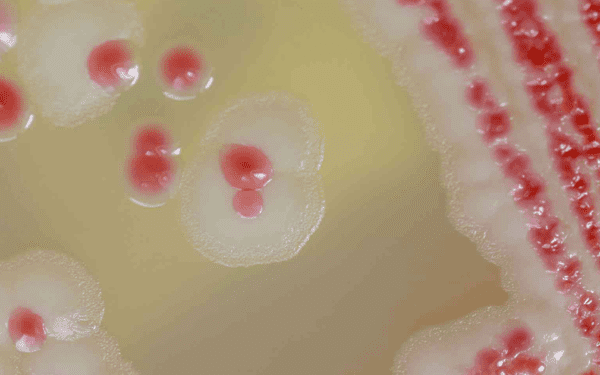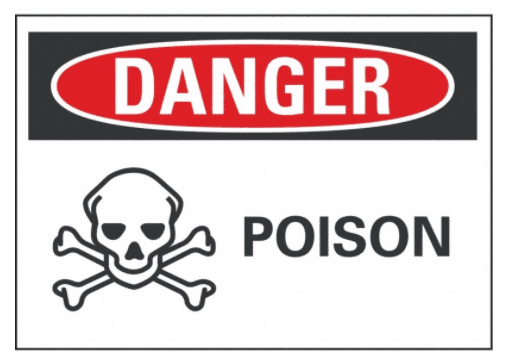
If you have noticed a pinkish stain in your bathroom or other parts of your home, you may have a pink mold infestation. Pink mold can look pretty gross and it is certainly not something you want in your home, so how do you get rid of it?
For the vast majority of people, pink mold is not dangerous. That being said, for some with weakened immune systems or other underlying conditions, pink mold could be a danger. Though it is not likely to be dangerous in your home, pink mold looks ugly and you should definitely remove it. To get rid of pink mold, scrub it vigorously with a bleach based cleaner. Dry the cleaned area and try to keep it dry to stop pink mold from coming back.
Understanding pink mold will help you to kill it and make sure that it won’t easily come back. Keep reading to learn everything you need to eliminate pink mold from your home.
What is Pink Mold?
It turns out that pink mold is a misleading name, because it is actually a bacteria called Serratia marcescens. It can range in color from pink to red or orange. It is normally seen growing on shower grout, or around the drain of sinks with a slimy or fuzzy appearance. Serratia marcescens is a very common bacteria that eats fat or phosphorus- containing substances.
Is Pink Mold Dangerous?

Pink mold is not dangerous to a healthy human. It is known as an opportunistic pathogen because it needs some rare opportunity to cause problems. It can pose a risk to those with compromised immune systems or with underlying conditions. Getting rid of pink mold is not an emergency situation, but you should get rid of it as soon as it is convenient.
A small colony of pink mold will not normally be a health threat, but if it gets big enough it can be a problem for some people. It can cause urinary tract infections, blood poisoning, pneumonia or gastrointestinal problems. If Serratia marcescens is able to enter an open wound, it can cause an infection that may require antibiotics.
According to an interesting article from Smithsonian Magazine, in 1950 the U.S. military spent six days spraying Serratia marcescens into the air off the coast of San Francisco as part of biological warfare testing. They thought it was a completely harmless bacteria that would be easy to study its effects on the city because of its bright color.
Unfortunately, 11 people were sent to the hospital with rare urinary tract infections following the tests. 11 people out of the entire city of San Francisco is a small percentage, but still, from this terrible experiment we can see that pink mold can be dangerous to human health.
Serratia marcescens poses the greatest risk to people who are in the hospital. According to Medscape.com, 1.4% of all infections acquired in the hospital are caused by the bacteria.
What Happens if you Breathe in Pink Mold?

Unlike the dreaded black mold, pink mold does not release toxic spores into the air, so there is little danger from breathing in pink mold. If you were unlucky enough to kick up some pink mold into the air and then breathe it in, that would be a health concern, but that is pretty unlikely and almost impossible when you take safety precautions.
Serratia marcescens is abundant in the environment, so we live with it whether we can see it or not. As long as pink mold does not enter your body, it most likely won’t cause any problems. But if you don’t get rid of it, it will keep growing and the chances of it finding an opportunity to enter your body increases. Get rid of pink mold fast and it almost certainly won’t hurt you.
How To Get Rid of Pink Mold
Wear protective gear when cleaning pink mold:
- rubber gloves
- N-95 mask
- Eye protection
- Long clothing- to prevent any of the bacteria from touching your skin
Mix four parts baking soda and one part dish soap to create a paste. Scrub the paste onto areas where you can see pink mold as well as a buffer four inches around the affected areas. Scrub so there is no more pink mold showing.
- Be careful not to scrub the grout too hard, as it could get damaged. Use a soft bristle brush and scrub longer, not harder.
Wash the paste off completely with some water.
Next, make a one to one solution of chlorine bleach and water and wipe it onto the affected area. Let a layer of the bleach solution sit for five to ten minutes then wash it off with some pure water. The bleach will kill any tiny bacteria particles that were left behind after the initial scrubbing.
Finally, dry the area with a squeegee and a towel. Let the area dry at least overnight or longer if possible to kill any surviving bacteria.
You should also make sure to do a full bathroom cleaning and disinfecting to make sure there is no bacteria hiding where you can’t see it. Wash your shower curtain if you have one and it is best to throw away your shower liner and buy a new one.
Does Vinegar Kill Pink Mold?

Yes, the acidity of vinegar will kill almost anything that is soaked in it long enough. We recommend using bleach because it works faster at killing pink mold. According to Tasteofhome.com, vinegar will take up to an hour to kill mold. Keep in mind this is factoring in other types of mold, so it will likely take less than an hour for pink mold, but it is better to be on the safe side!
Also, the acidity of vinegar could do damage to your grout with that longer sitting time. Vinegar is a wonderful natural cleaner, and we recommend it more as a preventative measure than to get rid of a pink mold infestation.
Never mix vinegar and bleach, because it creates toxic chlorine gas. Bleach has bad reactions with many other chemicals, so it is best not to mix bleach with anything except water.
What Causes Pink Mold in a Shower?
Most pink mold is found in a shower or bathtub because it thrives in the moist environment. Serratia marcescens is a fairly common bacteria that can come off of our bodies when we take a shower, then it feeds off the fats in soaps or body oils. A shower is basically a perfect home for the bacteria that causes pink mold.
How To Prevent Pink Mold
Keeping the areas where you have found pink mold clean is the best way to prevent it from coming back. Doing a thorough, weekly cleaning will make it hard for the bacteria to grow because you will be removing soap scum and other materials the bacteria needs to eat.
The bacteria that causes pink mold needs moisture, so if you can keep the area dry, the pink mold won’t be able to come back. Use a squeegee to push water into a drain and use a towel to dry up water that you are not able to get into the drain. Adding a dehumidifier to the room could also help to remove moisture and stop pink mold from growing.
You can also spray an anti- bacterial shower spray, bleach water or vinegar on the pink mold affected areas after each use or at least once per week. This will kill any bacteria before it has a chance to make a home.
If you have any water leaks it is important to have them fixed by a licensed plumber. Eliminating sources of moisture like a leaking pipe will stop pink mold from growing.
It can be difficult to completely eradicate pink mold from your home, because it occurs naturally and abundantly all around us and can keep coming back into the home. It may be that pink mold will come back every few weeks if the area is not cleaned.
Why Does Pink Mold Grow on the Grout but not the Tile?
It is very common to see pink mold growing only on the grout in a shower and this is because the grout has a rough surface that the bacteria can hold onto. The tile is just too slippery and the bacteria can’t easily make a home there.
Sometimes if you use too abrasive of a brush or cleaning product, it could rough up the tile and this will allow the bacteria to grow there. This is why you need to be careful when scrubbing away the pink mold, scrubbing too hard can actually make the problem worse.
Should you Hire a Professional to Get Rid of Pink Mold?
Hiring a professional is a great idea because they will know exactly how to get rid of pink mold and guarantee their work. They will have all of the safety equipment to make the job safe and they will use special tools to get rid of all of the bacteria.
While this article gives you all of the information you need to get rid of pink mold, there is a chance you could make an error and the pink mold will be back quickly. Hiring a professional mold cleaner will give you a clean slate that will make prevention much easier.

